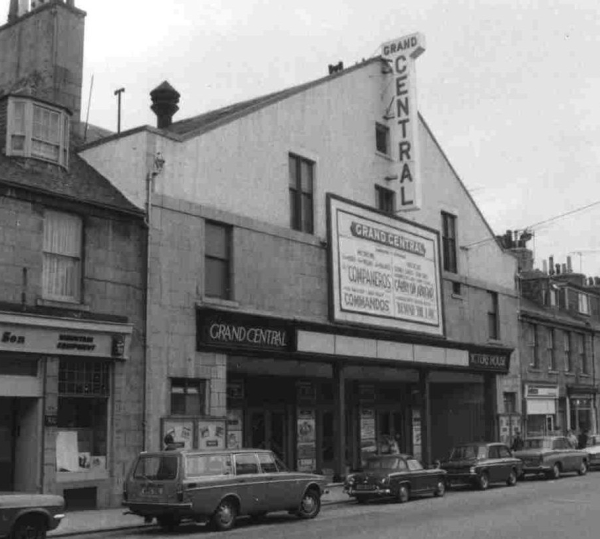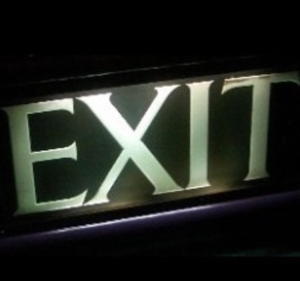The Grand Central opened on the
3rd of April 1922 for James Donald's circuit of cinemas, and was a
conversion of Allan's Stores at 286 George Street, in the northeast of
the city centre. The seating capacity of 730 was contained in a modest
single storey building, with a small balcony in the largely unadorned
auditorium. Pilasters on the sidewalls supported fake ceiling beams to
provide the only real decorative touches, with crimson seats, cork
linoleum and carpets underneath. The foyer was entered through three
sets of double doors, with a central pay box inside, to either side of
which were stalls and balcony entrances. Opening the cinema was
the main feature, "Over the Hill", with a full supporting programme.
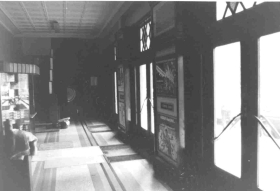
Foyer
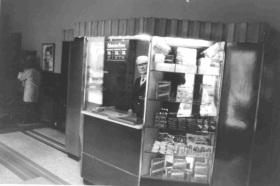
Kiosk |
Having been built in the silent era, a 4-piece orchestra provided
musical accompaniment, initially under the direction of Harold Pollard.
Later musical directors included Burton Denham, J.M. Taylor, Marjorie
Littlejohn (under whom the orchestra swelled to 7 members in 1926),
F.J. Archer and Jack Robinson.
Within only a few years of
opening, owner James Donald had acquired adjacent properties with a
view to expansion, but plans drawn up in 1927 by architect George Watt
were postponed, and his enlarged, but still plain, wood-panelled scheme
was never implemented. He does, however appear to have had a hand in
the actual expansion, which eventually happened in the last few months
of 1929. Complete closure proved only to be necessary for 6 weeks
between November 16th and December 29th.
What re-opened on December 30th was a completely different cinema - the
original stone facade was now capped by a large, triangular upper
storey, with a harled finish. The centre of this new facade sported a
good-sized advertising board, with three large windows behind and to
either side of it. Above this, a vertical name sign ran down the
central axis of the triangular profile, covering a single, smaller
window higher up the facade. The canopy over the main doors now
proclaimed the building to be the "Grand Central Picture House Super
Cinema". |
Inside, the changes were even more dramatic. The capacity of the
auditorium had more than doubled to 1,640, and the decoration was
partially in the "atmospheric" style, which had proved popular in
America, but was less common at this time in the UK. Two platforms
flanked the sidewalls to either side of the proscenium, one supporting
atmospheric elements of the decor, the other the orchestra. Arched
niches under these platforms were filled with lighting and plants,
whilst the platform itself was edged with a small balustrade. On the
walls, painted murals around the proscenium and the sidewalls depicted
hanging vegetation, clouds and further balustrades. The proscenium was
framed on either side by decorated pilasters, which were topped by
capitals supporting a sweeping arch over the top. A repeated pattern of
small square coffering decorated both the barrel-vaulted ceiling, and
the underside of the balcony in the rear stalls. Panels of plaster
garlands also festooned the front of the balcony. Large octagonal
ceiling lights that ran along the middle of the barrel-vaulted
ceiling
illuminated the space. The grand reopening was attended by the Lord
Provost, who viewed "The Three Rings" as the main feature during an
evening that also saw a performance by a Welsh Miners Quartet.
Only
a few months later, in April 1930, the Grand Central was wired for
sound, and presented Bulldog Drummond as the first talkie.
Interestingly, it had earlier screened a silent version of The Jazz
Singer, with live singing by one Jack MacLachlan - billed as the
Scottish Al Jolson - making up for the absence of a recorded soundtrack!
By
the mid-50s, the Grand Central witnessed yet another refurbishment,
this time to accommodate a Cinemascope screen. By now, most of the
atmospheric elements had gone, painted over or removed. The stage area
and orchestra platform were replaced by a new, simpler proscenium,
built further into the stalls, but some elements of the original
proscenium were said to survive behind these alterations. The new
screen was framed by a red rectangular proscenium arch, adorned with
gold stars, behind which a new screen-end wall was built without
decoration, bar vertical pink and beige stripes.
The closure
of the City cinema in 1963 saw that cinemas Simplex projectors replace
the Grand Central's Kalee machinery, and in around 1973, the entrance
to the cinema was tidied up, and the canopy altered so that it now
simply read "Grand Central Picture House". 1977 also saw the addition
of a new illuminated sign. By this time, the auditorium was a shadow of
its 1929 rebuild, with only the coffered ceiling and the plaster
garlands on the balcony front giving any idea of former glories.
Closure finally came at the same time
as James Donald's Queen's cinema, on October 17th 1981, and with them
both, the last vestiges of his main cinema exhibition business. The
building itself survived until 1984, when it was swept away for a
housing development.
|
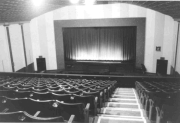
Auditorium Front
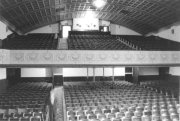
Auditorium Rear
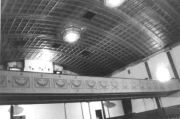
Ceiling
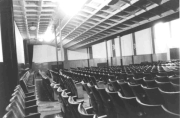
Rear Stalls
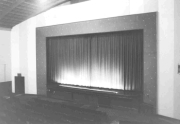
Proscenium |
|
